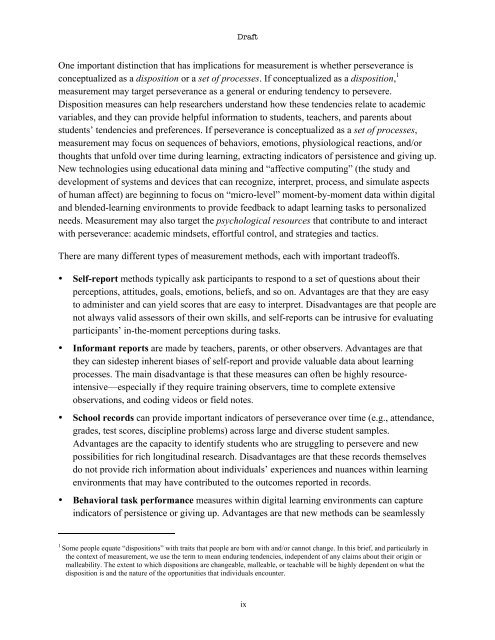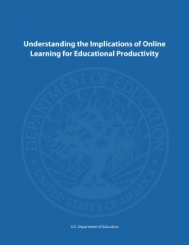Promoting Grit, Tenacity, and Perseverance - U.S. Department of ...
Promoting Grit, Tenacity, and Perseverance - U.S. Department of ...
Promoting Grit, Tenacity, and Perseverance - U.S. Department of ...
You also want an ePaper? Increase the reach of your titles
YUMPU automatically turns print PDFs into web optimized ePapers that Google loves.
Draft<br />
One important distinction that has implications for measurement is whether perseverance is<br />
conceptualized as a disposition or a set <strong>of</strong> processes. If conceptualized as a disposition, 1<br />
measurement may target perseverance as a general or enduring tendency to persevere.<br />
Disposition measures can help researchers underst<strong>and</strong> how these tendencies relate to academic<br />
variables, <strong>and</strong> they can provide helpful information to students, teachers, <strong>and</strong> parents about<br />
students’ tendencies <strong>and</strong> preferences. If perseverance is conceptualized as a set <strong>of</strong> processes,<br />
measurement may focus on sequences <strong>of</strong> behaviors, emotions, physiological reactions, <strong>and</strong>/or<br />
thoughts that unfold over time during learning, extracting indicators <strong>of</strong> persistence <strong>and</strong> giving up.<br />
New technologies using educational data mining <strong>and</strong> “affective computing” (the study <strong>and</strong><br />
development <strong>of</strong> systems <strong>and</strong> devices that can recognize, interpret, process, <strong>and</strong> simulate aspects<br />
<strong>of</strong> human affect) are beginning to focus on “micro-level” moment-by-moment data within digital<br />
<strong>and</strong> blended-learning environments to provide feedback to adapt learning tasks to personalized<br />
needs. Measurement may also target the psychological resources that contribute to <strong>and</strong> interact<br />
with perseverance: academic mindsets, effortful control, <strong>and</strong> strategies <strong>and</strong> tactics.<br />
There are many different types <strong>of</strong> measurement methods, each with important trade<strong>of</strong>fs.<br />
• Self-report methods typically ask participants to respond to a set <strong>of</strong> questions about their<br />
perceptions, attitudes, goals, emotions, beliefs, <strong>and</strong> so on. Advantages are that they are easy<br />
to administer <strong>and</strong> can yield scores that are easy to interpret. Disadvantages are that people are<br />
not always valid assessors <strong>of</strong> their own skills, <strong>and</strong> self-reports can be intrusive for evaluating<br />
participants’ in-the-moment perceptions during tasks.<br />
• Informant reports are made by teachers, parents, or other observers. Advantages are that<br />
they can sidestep inherent biases <strong>of</strong> self-report <strong>and</strong> provide valuable data about learning<br />
processes. The main disadvantage is that these measures can <strong>of</strong>ten be highly resourceintensive—especially<br />
if they require training observers, time to complete extensive<br />
observations, <strong>and</strong> coding videos or field notes.<br />
• School records can provide important indicators <strong>of</strong> perseverance over time (e.g., attendance,<br />
grades, test scores, discipline problems) across large <strong>and</strong> diverse student samples.<br />
Advantages are the capacity to identify students who are struggling to persevere <strong>and</strong> new<br />
possibilities for rich longitudinal research. Disadvantages are that these records themselves<br />
do not provide rich information about individuals’ experiences <strong>and</strong> nuances within learning<br />
environments that may have contributed to the outcomes reported in records.<br />
• Behavioral task performance measures within digital learning environments can capture<br />
indicators <strong>of</strong> persistence or giving up. Advantages are that new methods can be seamlessly<br />
1<br />
Some people equate “dispositions” with traits that people are born with <strong>and</strong>/or cannot change. In this brief, <strong>and</strong> particularly in<br />
the context <strong>of</strong> measurement, we use the term to mean enduring tendencies, independent <strong>of</strong> any claims about their origin or<br />
malleability. The extent to which dispositions are changeable, malleable, or teachable will be highly dependent on what the<br />
disposition is <strong>and</strong> the nature <strong>of</strong> the opportunities that individuals encounter.<br />
ix
















